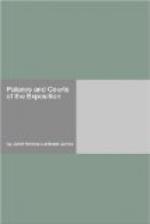The Colosseum and St. Peter’s at Rome are both made of this material.
The imitation travertine made with concrete, and used in the second story of the Pennsylvania Station in New York in combination with real travertine of the first story, was invented by Mr. Symmes Richardson of the firm of McKim, Meade and White of New York. He also brought the real travertine to America to have it used for the first time in a large building, the Pennsylvania Station.
Mr. Paul Deneville of New York has most successfully made a plastic travertine, composed of gypsum from Nevada combined with hemp fiber and a coloring pigment, which has been applied to all of the Exposition buildings, producing a most pleasing glareless background under the sunny skies of San Francisco.
The roofs are covered with imitation tiles, since real tiles would be too expensive for Exposition purposes.
Material of the Statues
The architectural statues — that is, those directly connected with the architecture — are of smoked-ivory tone, so that you see them as part of the architectural scheme.
Those far away from the eye, used as free statues, are, in the main, golden.
Those nearer the eye simulate bronze, the special color that seems worked out from the color of the blue eucalyptus.
All the statues of the Exposition palaces and courts are of travertine, the material of which the buildings are made.
Machinery Palace
Architects — Ward and Blohme of San Francisco.
The palace is one of grandeur, dignity and great beauty.
The architecture has been inspired by such old Roman
thermae as the
Baths of Caracalla, the Baths of Titus and the like.
The ornamentation is of the Italian Renaissance style, worked out on a building that in form suits the needs of a great palace of machinery.
The gable points at the top of the western façade are such as one sees in the restoration of the Baths of Caracalla.
The first and only other expression of this style in America is seen in the Pennsylvania Station of New York City.
In the Transportation Palace can be seen a model of the proposed plan for a new Union Depot for Chicago, with a similar gabled effect.
The three arches reflect on the exterior the three aisles of the same portion of the palace within.
The great columns in front, and also in the vestibule, simulate Siena marble.
The entablature carried across the faces of the arches supports American eagles by C. A. Humphries.
Eagles are also seen at the corners of the Corinthian capitals. This bird of freedom can be found all over the Exposition.
Notice that Mr. Jules Guerin, the great color wizard, leads you by means of the blue ground of the capitals, the blue between the dentils, the blue between the consoles to the blue sky above.




